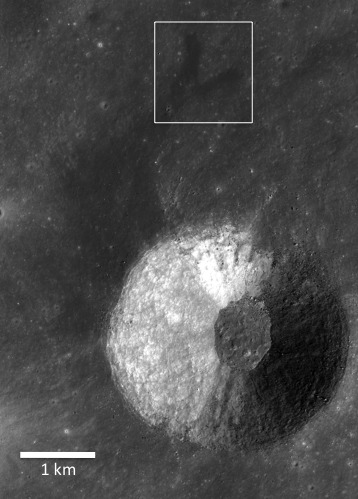
Young, Copernican-aged lunar impact craters exhibit spectacular deposits of lava-like material produced by shock melting in and around the craters. These lunar impact melts are observed as thin, hard-rock veneers, flows, and ponds. Today's Featured Image highlights a spectacular example of a large impact melt flow that flowed from a young small highlands crater (~3.1 km in diameter). The distal portion of this curved impact melt flow splits into two separate flows (opening image) about 2.5 km from the crater rim. What caused this impact melt flow to fork?
Local topography most likely influenced the impact melt flow path. At the point where the two flows diverge, the main flow is 320 m wide. The northern flow segment extends 675 m beyond the point of divergence and is 200 m wide near its end. The northeastern segment extends for 550 m from the main flow and is 210 m wide near its end. Both flow segments exhibit numerous cracks along portions of their lengths.
The white box indicates the area of the Featured Image (above). This context image is a portion of a mosaic of two NAC frames (M112902715L and R) and includes the source crater for the forked impact melt flow. Image width is 4.3 km, illumination is from the right [NASA/GSFC/Arizona State University].
The impact melt deposits associated with this farside crater are unique for two reasons. First, the volume of melt present on the crater exterior is exceptionally large, especially when compared to the melt deposits observed on the crater floor. Second, the exterior melt deposits are found at large distances from the crater rim. Studies of impact melt deposits during the Apollo era indicated that craters in the ~3-4 km diameter size range exhibited only very small volumes of exterior melt concentrated near the rim crests. Observations of <5 km diameter craters using the LROC NAC images will greatly improve scientists' understanding of impressive impact melt flows such as this one!
Investigate the impact melt flows at other locations around this crater for yourself!
Published by B. Ray Hawke on 22 June 2010
